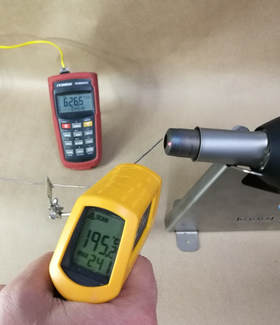Why you Can’t Measure Air Temperature with a Laser IR Gun and a Simple, Effective Alternative7/18/2018
While Laser IR Thermometers are an extremely common tool, they are entirely ineffective for measuring the outlet temperature of an air heater. To understand why, we must first understand how this tool works. Laser IR Thermometers measure the surface temperature of an object by measuring the thermal energy emitted by the target. Knowing the amount of thermal energy discharged and the emissivity of an object’s surface, the object's temperature can be determined by the device.
When measuring a heater’s output air temperature, the largest issue with these tools is that they measure surface temperatures. As the heated air is transparent, the measurement will always be the surface temperature of a nozzle or a component of the heater housing; and frequently it will be an exterior surface. These items will always be cooler than the heated air, often by a significantly larger margin than the user would expect. To accurately measure the output temperature of an air heater you must measure air temperature and laser IR thermometers are incapable of doing so.
The above paragraph covers the most important reason these devices are ineffective for measuring air temperature, below are some quick points on why the reading can be even further from the true air temperature:
What to Use Instead
To effectively measure the output temperature from an air heater, STANMECH recommends a physical probe be used. The most common device is a K Type thermocouple[1], this is what STANMECH uses for all air temperature measurements in our lab and in the field. When using the thermocouple, place the tip of the probe directly into the hot air stream (preferably in a way that allows for good impingement of air against the tip) and let it rest until the measurement on your reader reaches a steady state. Make certain the tip of the probe is does not make contact with any nozzle, pipe, or heater surfaces; it should only be in contact with the output air flow. This method will provide an accurate measurement of the output temperature from your heater.
Having trouble with your tool? Contact your Technical Sales Representative for help troubleshooting.
[1] The K Type thermocouple is only the probe component, you will also need a readout device that takes the signal from the thermocouple and outputs it to a digital display. Comments are closed.
|
|
STANMECH Technologies Inc.
944 Zelco Drive Burlington ON L7L 4Y3 | 1-888-438-6324 | [email protected] Terms of Use Privacy Terms and Conditions of Sale Warranty Policies |
|
Proud Member of:


